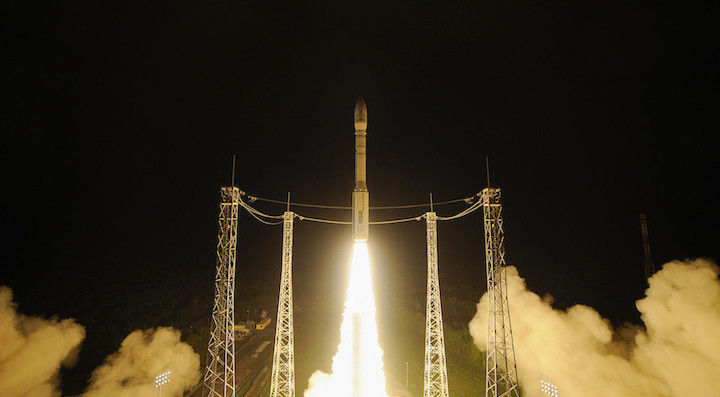10.05.2019

WASHINGTON — Arianespace has finalized the payload for a Vega launch later this year that will carry more than 40 small satellites, the first in what the company hopes to be a series of dedicated rideshare missions.
Arianespace announced May 9 the final contract for its initial Small Spacecraft Mission Service (SSMS) launch, a smallsat called ESAIL for Canadian company exactEarth. The satellite, built by Luxembourg-based LuxSpace through a partnership program with the European Space Agency, will join exactEarth’s fleet of satellites that track Automatic Identification System (AIS) signals from vessels.
The 110-kilogram ESAIL will join 41 other satellites on the SSMS “Proof of Concept” mission to demonstrate the use of the rocket for launching a large collection of smallsats. ESAIL is the final spacecraft to be added to the mission.
“We are fully booked. We have no gram left of performance,” Marino Fragnito, vice president of the Vega business unit at Arianespace, said of that mission during a panel discussion at the Satellite 2019 conference here May 8.
He added that the mission’s orbit had to be lowered slightly due to the mass of all the satellites on the vehicle. The Arianespace release about ESAIL said the spacecraft would be released into a 515-kilometer sun-synchronous orbit.
While Arianespace said that the launch was only scheduled for “this summer,” Fragnito gave a specific launch date, Sept. 5, during the panel discussion. “When we started planning this mission two years ago, we targeted a launch in March 2019,” he said. He said he considered that slip of several months to still being close to on schedule, and argued that the slippage was due to delays in the satellites and “some manifest adjustments” in the overall schedule of Vega missions.
Among the customers announced for the first SSMS mission are rideshare service providers Innovative Solutions in Space, D-Orbit and Spaceflight, as well as smallsat developer Sitael. The satellites range from microsatellites weighing 160 kilograms down to single-unit cubesats, Fragnito said.
There were more prospective customers for that mission than could be accommodated on the rocket. “We had customers asking to come, but we cannot take them onboard,” he said. “I think this is what we would call a success.”
A second SSMS mission is planned for 2020, and is almost fully booked, Fragnito said. That will fly on a “dawn-dusk” sun-synchronous orbit, the first rideshare mission to that specific orbit that he said he was aware of. An advantage of using the Vega from the spaceport in Kourou, French Guiana, he noted, was the wide range of orbital inclinations available for launches from there.
Arianespace plans to fly SSMS missions on a regular basis in the future, although he said the company hasn’t decided on a specific flight rate yet. “We want to do SSMS as frequently as possible.”
Quelle: SN

